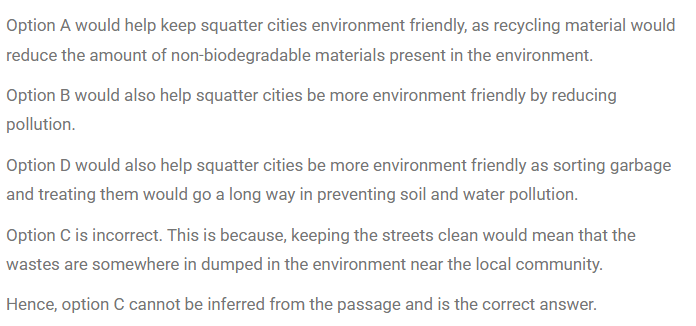CAT RC Questions | CAT RC Based on Natural Science questions
FundaMakers is the Best CAT Online Coaching In India. Now prepare for CAT anytime with FundaMakers. We provide well-ordered syllabus coverage for both offline and online CAT preparation batches. FundaMakers brings to you the power-packed, well-structured CAT previous year question bank with more than 4000+ CAT Past Year questions. In the VARC section, one of the most frequently asked questions is from the topic- Reading Comprehension. Reading Comprehension turns out to be an important part of the VARC section from which over 60-70% of the questions are based on RC in the CAT Exam.
FundaMakers as a team has taken a painstaking step to bring you all the video solutions of the Reading Comprehension asked in the Previous Year CAT exam. CAT question bank offered by FundaMakers is a power-packed topic-wise compilation of the entire CAT previous year questions. Questions from the Reading Comprehension topic are some of the most scoring questions in the VARC section. To maximize your CAT score make use of FundaMakers CAT Question Bank. “Questions from CAT previous years” examination papers have been incorporated. Let’s get started with CAT Past Year Reading Comprehension Questions.
Comprehension
Directions for question: Read the passage carefully and answer the given questions accordingly
The magic of squatter cities is that they are improved steadily and gradually by their residents. To a planner’s eye, these cities look chaotic. I trained as a biologist and to my eye, they look organic. Squatter cities are also unexpectedly green. They have maximum density—1 million people per square mile in some areas of Mumbai—and have minimum energy and material use. People get around by foot, bicycle, rickshaw, or the universal shared taxi.
Not everything is efficient in the slums, though. In the Brazilian favelas where electricity is stolen and therefore free, people leave their lights on all day. But in most slums recycling is literally a way of life. The Dharavi slum in Mumbai has 400 recycling units and 30,000 ragpickers. Six thousand tons of rubbish are sorted every day. In 2007, the Economist reported that in Vietnam and Mozambique, “Waves of gleaners sift the sweepings of Hanoi’s streets, just as Mozambiquan children pick over the rubbish of Maputo’s main tip. Every city in Asia and Latin America has an industry based on gathering up old cardboard boxes.” . . .
In his 1985 article, Calthorpe made a statement that still jars with most people: “The city is the most environmentally benign form of human settlement. Each city dweller consumes less land, less energy, less water, and produces less pollution than his counterpart in settlements of lower densities.” “Green Manhattan” was the inflammatory title of a 2004 New Yorker article by David Owen. “By the most significant measures,” he wrote, “New York is the greenest community in the United States, and one of the greenest cities in the world . . . The key to New York’s relative environmental benignity is its extreme compactness. . . . Placing one and a half million people on a twenty-three-square-mile island sharply reduces their opportunities to be wasteful.” He went on to note that this very compactness forces people to live in the world’s most energy-efficient apartment buildings. . . .
Urban density allows half of humanity to live on 2.8 per cent of the land. . . . Consider just the infrastructure efficiencies. According to a 2004 UN report: “The concentration of population and enterprises in urban areas greatly reduces the unit cost of piped water, sewers, drains, roads, electricity, garbage collection, transport, health care, and schools.” . . .
[T]he nationally subsidised city of Manaus in northern Brazil “answers the question” of how to stop deforestation: give people decent jobs. Then they can afford houses, and gain security. One hundred thousand people who would otherwise be deforesting the jungle around Manaus are now prospering in town making such things as mobile phones and televisions. . . .
Of course, fast-growing cities are far from an unmitigated good. They concentrate crime, pollution, disease and injustice as much as business, innovation, education and entertainment. . . . But if they are overall a net good for those who move there, it is because cities offer more than just jobs. They are transformative: in the slums, as well as the office towers and leafy suburbs, the progress is from hick to metropolitan to cosmopolitan . . .
CAT/2019.2
Question . 55
According to the passage, squatter cities are environment-friendly for all of the following reasons EXCEPT:
Explanatory Answer
Method of solving this CAT RC Question from RC Based on Natural Science question
Correct Option: C

Hey!
Worried about IIM calls due to your marks in 10th,12th, and Graduation?
Don't worry! Know your chances of getting an IIM Call based on your profile with our:-
Profile Professor: https://fundamakers.com/profile-professor/

5 Must- NOT-Dos during CAT Preparation.
- Do not treat CAT as 'Everything'.
- Do not quit your job for CAT exam preparation.
- Learning till The Eleventh hour instead of doing proper revision.
- Not checking the syllabus thoroughly.
- Piling up multiple books.
Click To Read:- Common mistakes made by CAT aspirants during preparation.
FundaMakers- Best Online and Offline CAT Online Preparation Institute in India
For any CAT Preparation related query, reach out to us at 9598333344.